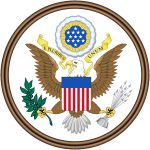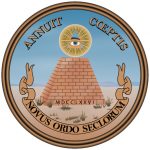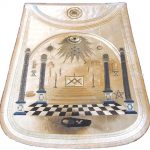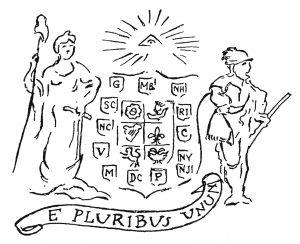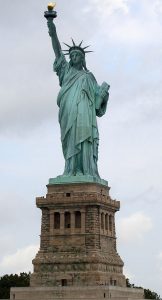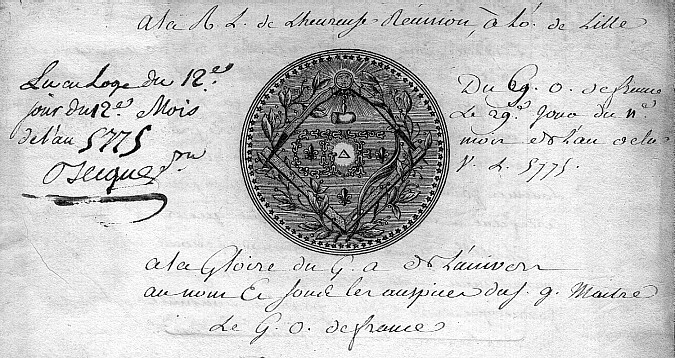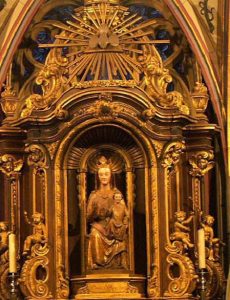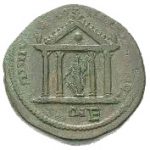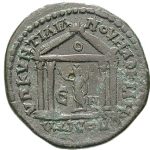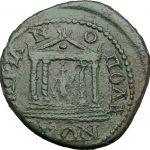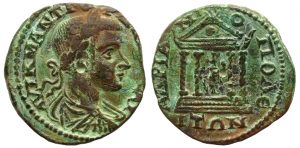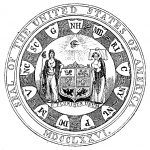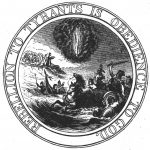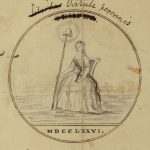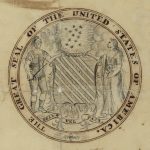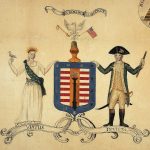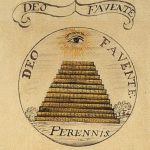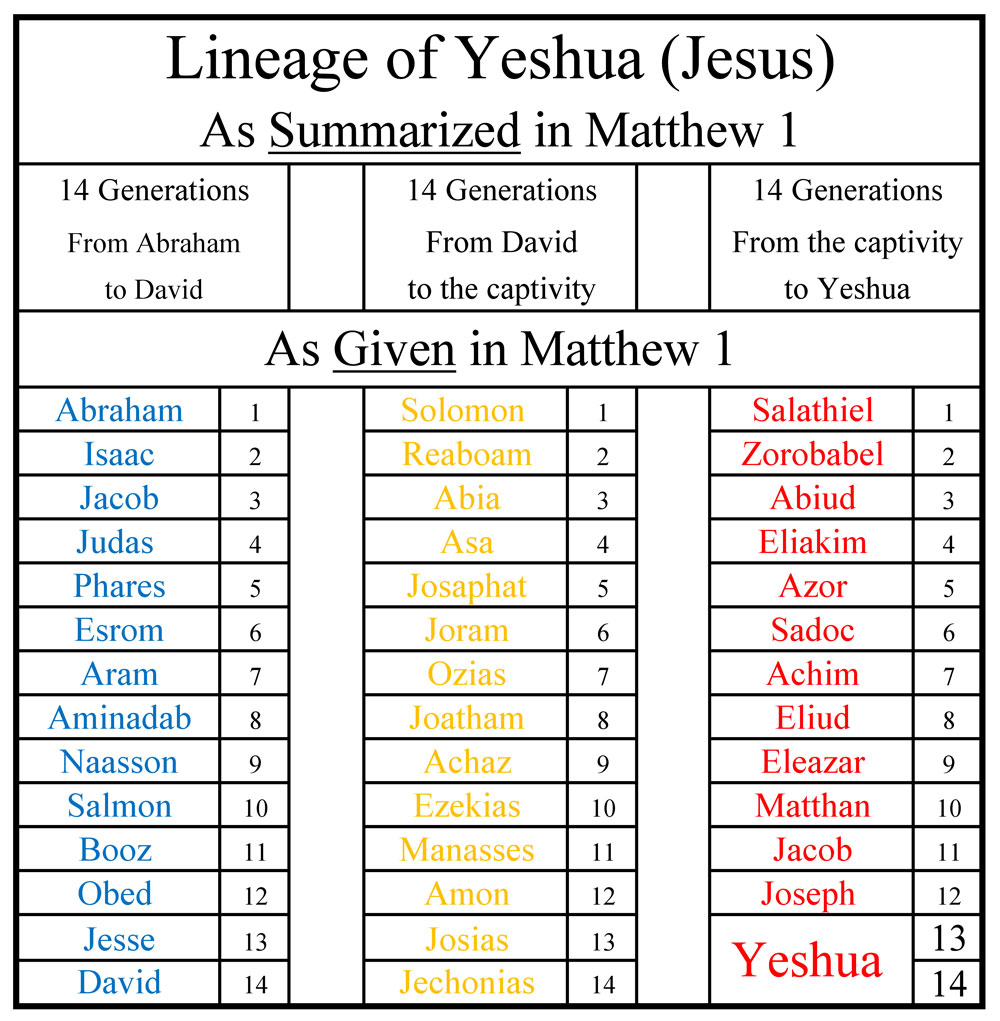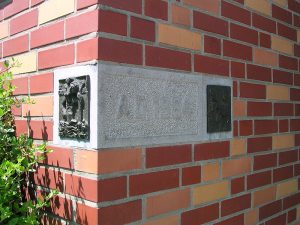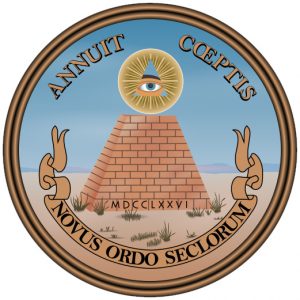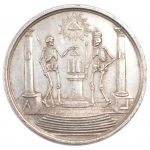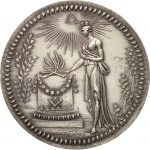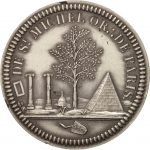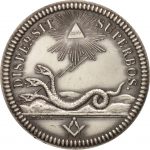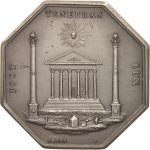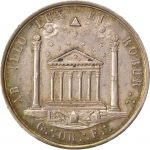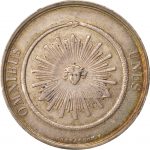Nearly everyone recognizes the images reproduced in this week’s blog post. In fact, nearly every American citizen and a great many citizens of the world have held a version of these famous American symbols in their hand over the course of their life.
To some the symbol on the left represents (among other things) the benevolence and watchfulness of God over the founding of our new nation. To others, especially over the past century, the symbol has become tangible evidence of some grand conspiracy originated by our founding fathers.
As with many versions of history, the truth is sometimes more complicated and fascinating than either side is often willing to admit. Today, let’s explore the Great Seal of the United States, that famous symbol of patriots and conspiracy theorists.
The Great Seal, like few other American symbols, represents the complexity, intrigue, and world views of America’s founders and the people they had the responsibility of governing. I think you’ll be surprised at how some of our founding fathers saw the symbolism of the Great Seal, but even more intriguingly, how one of the 19th and 20th century’s most influential secret societies has used this symbolism to exemplify their world view and goals for the new American republic.
The First Committee
Our story begins in the afternoon of July 4, 1776 shortly after members of the Continental Congress declared American Independence. On that auspicious day the Congress passed a resolution empowering a committee composed of John Adams, Benjamin Franklin, and Thomas Jefferson to prepare a “device for a seal of the United States of America”.
This seal was to be the official device or coat of arms, so to speak, of the new United States of America which would be used to mark all official documents. As such, the founders wanted its symbolism to represent the people’s vision for the new nation.
To help with the first design, the committee engaged the help of the naturalist and artist Pierre Eugene du Simitiere. Simitiere was a fellow member of Benjamin Franklin’s American Philosophical Society, originally known as the Junto (joined) aka, The Leather Apron Club. The name Leather Apron Club likely originated because many members of the club were tradesmen who wore leather aprons or because many of its members were also Freemasons who were known for their ceremonial leather aprons.
In fact, George Washington and Marquis de Lafayette were both members of APS. According to Masonic legend in 1784, while visiting Mount Vernon, Lafayette (who was also a Freemason) presented the above Masonic apron to George Washington.
In any case, Simitiere was brought in for his skills as an artist. Simitiere presented the committee with the following drawing for the obverse of the seal. There are several fascinating aspects to this seal which should be noted because they help us understand Simitiere’s and by extension the committee’s world view at the time.
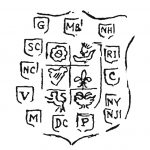 First, the six symbols in the center of the shield represent the principle nations from which America was born. They were: England, Scotland, Ireland, France, Germany, and Holland. The motto below the shield read E PLURIBUS UNUM, which was a Latin phrase that meant One Out of Many. Both the shield and the motto convey the old European (Roman) origins of the American people.
First, the six symbols in the center of the shield represent the principle nations from which America was born. They were: England, Scotland, Ireland, France, Germany, and Holland. The motto below the shield read E PLURIBUS UNUM, which was a Latin phrase that meant One Out of Many. Both the shield and the motto convey the old European (Roman) origins of the American people.
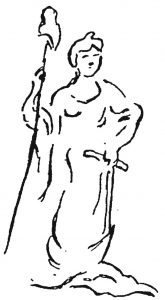 On the left side of the shield the goddess Liberty is represented holding a spear or staff with a pileus (Phrygian) cap. Liberty or Libertas, as she was known to the Romans, was the goddess they enshrined when they overthrew the monarchy of the Tarquin kings and established the Roman republic. In 238 BC a temple on Aventine Hill was built to honor the goddess Libertas.
On the left side of the shield the goddess Liberty is represented holding a spear or staff with a pileus (Phrygian) cap. Liberty or Libertas, as she was known to the Romans, was the goddess they enshrined when they overthrew the monarchy of the Tarquin kings and established the Roman republic. In 238 BC a temple on Aventine Hill was built to honor the goddess Libertas.
Today, one of the most famous examples of the goddess Libertas is found on Liberty Island in New York City. You and I know the goddess Libertas as the Statue of Liberty or her more formal title Liberty Enlightening the World. The Statue of Liberty was a gift from the French to the American people. The statue was designed by the French Freemason sculptor, Frederic Bartholdi.
In Simitiere’s design for the seal, Libertas, in her right hand, is holding a spear or staff with a pileus (Phrygian) cap. In the late Roman republic this cap was a symbol of the return to Roman republicanism. Wikipedia explains:
From Phrygian to liberty cap
In late Republican Rome, a soft felt cap called the pileus served as a symbol of freemen (i.e. non-slaves), and was symbolically given to slaves upon manumission, thereby granting them not only their personal liberty, but also libertas— freedom as citizens, with the right to vote (if male). Following the assassination of Julius Caesar in 44 BC, Brutus and his co-conspirators instrumentalized this symbolism of the pileus to signify the end of Caesar’s dictatorship and a return to the (Roman) republican system.[2]
These Roman associations of the pileus with liberty and republicanism were carried forward to the 18th-century, when the pileus was confused with the Phrygian cap, with the Phrygian cap then becoming a symbol of those values. (https://en.wikipedia.org/wiki/Phrygian_cap)
On the right side of the shield is an American rifleman with a tomahawk. Here the symbolism speaks for itself.
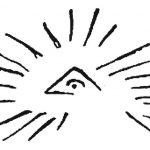 Finally, at the top of the proposed seal we have the most intriguing symbol of them all. Above the shield is a triangle with an eye at its center with rays of radiance surrounding it. The most common interpretation of this symbol is that it represents Divine Providence bestowing His blessing and/or protection on the new American republic. On the other side, are those who claim this eye in a triangle is the symbol of the Illuminati.
Finally, at the top of the proposed seal we have the most intriguing symbol of them all. Above the shield is a triangle with an eye at its center with rays of radiance surrounding it. The most common interpretation of this symbol is that it represents Divine Providence bestowing His blessing and/or protection on the new American republic. On the other side, are those who claim this eye in a triangle is the symbol of the Illuminati.
Let’s put the conspiracy theory to rest right up front. There is no credible historical evidence to show that the eye and the triangle was the symbol of the Illuminati. What we do know about the Illuminati is that they marked their communications with the symbol of a point within the circle. Although the point within the circle has a similar symbolic meaning to the open eye, the two symbols are not the same.
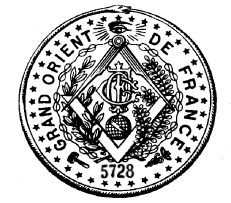 To find an 18th century contemporary example of a triangle with the eye of providence inside we must look to French Freemasonry. In France the Grande Orient Lodge was founded in 1728 and one of its most prominent symbols is the All Seeing Eye as represented by their seal in the picture on the right. Note also the date on the Grande Orient seal. If you remember from our previous article, Masonry used Anno Lucis (year of the light) to date many of their official documents.
To find an 18th century contemporary example of a triangle with the eye of providence inside we must look to French Freemasonry. In France the Grande Orient Lodge was founded in 1728 and one of its most prominent symbols is the All Seeing Eye as represented by their seal in the picture on the right. Note also the date on the Grande Orient seal. If you remember from our previous article, Masonry used Anno Lucis (year of the light) to date many of their official documents.
At some point after 5728 (1728) French Freemasonry started placing the All Seeing Eye inside a triangle. Interestingly, this French Grande Orient Lodge document (below) dated to the year 5775 (1775) shows only a point within the triangle surrounded by the glory cloud. Towards the late 18th century the All-Seeing Eye became much more prominent in French Grande Orient Freemasonic symbolism.
But that is not the entire story. Long before the symbol was appropriated by Freemasonry it was used in devices and buildings of the Holy Roman Empire. One of the first known examples of a triangle with a glory cloud (though missing the “eye of providence”) is found in Aachen cathedral built
(796-805 AD) by Charlemagne, the first Holy Roman Emperor.
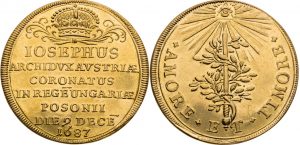 Another example is found on this coin honoring the coronation of Holy Roman Emperor Joseph I dated to 1687 AD. This time the triangle with the glory cloud includes the “eye of providence”. Both of these examples appear in a religious context outside of Freemasonry and their view of God and mankind. If these symbols, as they were used during the Holy Roman Empire, had a deeper occult meaning, I would need more evidence for such symbolism than I’ve been able to find.
Another example is found on this coin honoring the coronation of Holy Roman Emperor Joseph I dated to 1687 AD. This time the triangle with the glory cloud includes the “eye of providence”. Both of these examples appear in a religious context outside of Freemasonry and their view of God and mankind. If these symbols, as they were used during the Holy Roman Empire, had a deeper occult meaning, I would need more evidence for such symbolism than I’ve been able to find.
Finally, it should also be noted that the symbol of a triangle with a point at its center is found on ancient Roman coinage honoring among others the god Seraphis. Here are a few examples from Roman coinage showing Thracian and Roman temples.
Freemasonry and the All Seeing Eye
It seems that when the Freemasonry appropriated the symbol of the All-Seeing Eye inside the triangle, the Catholic Church stopped using it. As is well documented in history, the Catholic Church and Freemasonry have long had animosity for each other as well as distinctly different views on religion. Whatever its symbolism was meant to be, when the Continental Congress appropriated this symbol, it was not being used as a Christian symbol at that time, but rather Masonic.
But this is where the story gets really interesting. When the Great Seal of the United States was under review by the committee, America was in the midst of the Revolutionary War. Historically we know that the new American republic was in desperate need of financial and military aid in its early years. To help secure that aid, Benjamin Franklin was dispatched to France as ambassador, serving from 1776 to 1785. As is well documented, Franklin was a member of both United States and French Masonic lodges.
It cannot be a coincidence (our founders were not that naive) that as part of the first committee’s design for the Great Seal, a symbol was used which would have had special appeal to French Freemasonry. The further beauty of the symbol would have been that the Great Seal committee could also legitimately claim “Christian” origins in the Holy Roman Empire, again emphasizing the Roman aspect of the Great Seal’s design.
Clever politics indeed!
But that was just the obverse side of the Great Seal. On the reverse side of the seal Franklin’s proposal of the children of Israel crossing the Red Sea was used (with some changes by Jefferson) and the motto included “Rebellion to Tyrants is Obedience to God”.
I think it is important to note here that this initial design of the Great Seal gives us a unique glimpse into the minds of three of America’s most influential founders. They saw America, first of all, as a new republic patterned after ancient Rome, where its citizens were justified in overthrowing tyrannically monarchal rule just as the ancient Roman’s had done.
One side of the Seal represents the Roman goddess Liberty and her commission to lead the ancient Romans in rebellion against monarchal rule. On the other side of the seal, the Hebrew god of the Bible (represented by the glory cloud) and His mandate to escape the tyrannical rule of Egypt’s Pharoah. Although both sides of the Seal are powerful metaphors for the American Revolution, I think it is only fair to say that neither side represents true Christian imagery.
Rejected
Even the best laid plans though don’t always work out. And in August of 1776 the committee presented Du Simitiere’s rendering of the design to the Continental Congress. The committee’s hard work was clearly not appreciated by a majority of Congress and the design was tabled, thus effectively killing it.
The Second Committee
Four years later in 1780, another attempt was made to address the lack of an official American seal. By now, the need was rather pressing.
A new committee was established consisting of John Morin Scott, William Churchill, and James Lowell. This time the services of Francis Hopkinson were acquired to help design the seal.
Hopkinson came up with two designs as seen above left. This seal kept the goddess Liberty and her pileus cap but added a glory cloud to the cap. Also kept from the original design was the glory cloud over the shield. Roman numerals for the date were also added. This design was also rejected by Congress.
The Third Committee
Two years later another attempt was made to design a seal for the United States. The committee consisted of John Rutledge, Arthur Middleton, and Elias Boudinot. Sometime later Arthur Lee replaced John Rutledge. This committee also acquired the services of an artist, this time the heraldic expert William Barton.
Barton’s design still incorporated Libertas but without her pileus cap. The cap was moved to the bust on top of the shield. The shield was moved to the obverse side of the seal and a burning torch with a phoenix or eagle was added. A phoenix was also added above the shield. Once again this design expressed the symbolism of Ancient Rome and the quest for renewed Roman republicanism. The phoenix (the rebirth of the republic) was the central symbol of the obverse side of the shield.
On the reverse side Hopkinson added a pyramid of 13 levels over which the “eye of providence” looked. Here the Roman words Deo Favente (God favors) and Perennis (everlasting) were written. Clearly the symbolism here was meant to emphasis the view that the 13 colonies rebellion against British rule was a God ordained enterprise which they hoped/believed would include his everlasting favor. Interestingly, Hopkinson borrowed the pyramid design from the $50 continental note which he had designed in 1778.
Charles Thomson – A Committee of One
The third committee’s design was met with little enthusiasm in Congress and it too was rejected. After this Charles Thomson, Secretary of the Continental Congress, was empowered to take all previous committee’s works and come up with a design. The design we have today comes from the fertile mind of this American founding father.
To better understand the symbolism expressed by Thomson’s seal, a few details about him need to be shared. Thomson could arguably be considered one of the most influential founding fathers due to his service as the Secretary of the Continental Congress for its entirety. Like few others, Thomson understood the intrigue, complexities, and challenges the key players faced in the formation of our new nation. He was there to record them all. Thomson was also a member of Franklin’s American Philosophical Society and as such, he was on the cutting edge of early American enlightenment thought.
Thomson was also a Biblical scholar in his own right. He gave the world the first English translation of the Septuagint as well as the first American English translation of the New Testament. These facts combine to give Charles Thomson a unique insight into the formation of this nation as well as a peculiar world view which he then incorporated into the Great Seal of the United States.
Thomson didn’t waste any time in coming up with a design for the Great Seal. On June 13, 1782, Thomson was given the responsibility of coming up with a design. By June 20, 1782 he submitted his design and it was accepted the same day. Now that is efficiency!
Unique Symbolism
Now that we’ve seen the three committee’s designs and the evolution of these designs we are in a good position to understand how each influenced Thomson’s final design.
What strikes me in looking at all three of the initial Great Seal designs, is their underlying thread emphasizing Roman origins. It is fascinating that our founders saw the new American enterprise as a sort of a revived Roman republic. Thomson kept this idea and amplified it in several clever ways.
On the obverse, of the Great Seal, Thomson used the Roman eagle (sacred bird of the Roman God Jupiter) as the primary motif. In the beak of the eagle is the 13 letter motto, “E Pluribus Unum” (one out of many). Remember this original motto, written in Latin (the language of ancient Rome) graced the first committee’s design below the shield showing the European (Roman) origins of the 13 colonies. Thomson set the new shield in the center of the Roman eagle where he then represented the 13 colonies by red and white stripes.
On the reverse side of the Seal, Thomson included two more Latin phrases which again emphasize the symbolism of ancient Roman. Interestingly, Thomson was a former Latin teacher and the phrase, Novus Ordo Seclorum (A New Order of the Ages) was believed to be inspired by the Roman poet Virgil’s pastoral poem, Eclogue IV. In the poem the priestess Sybill prophesies the fate of the Roman empire. The following translation comes from C.S. Calverley:
Come are those last days that the Sybil sang:
The ages’ mighty march begins anew.
Now come the virgin, Saturn reigns again:
Now from high heaven descends a wondrous race.
Thou on the newborn babe – who first shall end
That age of iron, bid a golden dawn. . .
Thou, trampling out what prints our crimes have left,
Shalt free the nations from perpetual fear.
While he to bliss shall waken; with the Blest
See the Brave mingling, and be seen of them,
Ruling that world o’er which his father’s arm shed peace.
Annuit Coeptis
Annuit Coeptis (favor our undertakings) written above the “eye of providence” is then translated, (using words and symbolism) “Providence has favored our undertaking”. Interestingly, Annuit Coeptis may also be traced to Virgil, this according to the authors Patterson and Dougall, Virgil’s Aeneid, book IX, line 62. The Latin phrase comes from a prayer to the Roman god Jupiter by Ascanius, the hero of the story, just before he slays his enemy, Numanus. It reads, Iuppiter omnipotens, audacibus adnue coeptis,
“Jupiter Almighty, favor [my] bold undertakings”.
I think it important to note here, that even though most of our founding fathers understood the importance of Judeo-Christian principles, they clearly had a rather open minded view of Divine Providence. The early Seal designs shows that many of them were comfortable with both a Hebrew god and the Roman gods and goddess as represented in those designs.
The Pyramid and the Eye
This brings us to the part of the US Seal that has captivated imaginations for nearly 250 years. Thomson took the original eye in the triangle and placed it over Hopkinson’s 13 level pyramid. This modified the original symbolism of an unfinished work of 13 levels and completed it with a representation of “Divine Providence” in a radiant triangle (the point in the circle of Ancient Roman temples, The All Seeing eye of the Holy Roman Empire, French Freemasonry, etc.). As we’ve seen in our exploration of this subject, this representation of the divine presence was likely not meant to be representative of an exclusively Biblical world view. In the spirit of religious inclusiveness demonstrated by ancient Rome, the Great Seal of the United States allows the individual to choose the god they wish to see.
Even so, the context of the Seal leaves open several possible symbolic explanations worth exploring:
1. The first that stands out is the capstone implies a future completed work under the supervision of divine providence. In other words, this new nation, which started with 13 colonies (13 level pyramid), will someday reach a completed and eternal state under god’s supervision (the capstone). Sort of an early American kingdom identity movement, if you will.
2. Another possibility is that Thomson, like the first committee, may have tried to acknowledge the influential role French Freemasonry played in the founding of our new republic. Credit has been given to many people for the first tentative steps taken by our new nation but without Benjamin Franklin and his influential connections to French Freemasonry, we may well have lost the Revolutionary War against the British Empire.
3. Finally, I can’t help but mention what might possibly be the only possible Christian symbolism expressed by the Great Seal of the United States. As I’ve already explained, Thomson had a considerable knowledge of the Bible. Remember, he was the first person to translate the Septuagint into English, and he also gave the world the first American English translation of the New Testament. As such, we must at least consider the possibility that his design may have had another deeper meaning as well.
If you’ve been a regular reader of this blog or if you’ve read my book The 13th Enumeration, then you are aware of the Messianic significance of 13 & 14 in the Bible. For those who aren’t aware, I’ll briefly explain and then show why this may be relevant to the Great Seal.
In the Matthew 1 we have one of the most controversial lineages in the Bible. This lineage tells of Yeshua’s (Jesus) ancestors. What’s fascinating about this list is, that Matthew describes it as three groups of 14 generations. Yet, when the actual names are counted, Matthew only provides 41 names or 14 + 14 +13. This in effect makes Yeshua the 13th generation or what I call the 13th Enumeration of Matthew 1. What is so special about this list is, that by Yeshua’s death and resurrection He became the de facto 14th generation thus completing the list. Then just like king David who is the 14th generation in the first 14 generational grouping, Yeshua became the 14th generation in the third generational grouping. Consider the prophetic words the angel gave to Mary the mother of Yeshua:
And, behold, thou shalt conceive in thy womb, and bring forth a son, and shalt call his name JESUS [Yeshua = YHWH’s Salvation]. He shall be great, and shall be called the Son of the Highest: and the Lord God shall give unto him the throne of his father David: (Luke 1:31-32)
Now consider another aspect of Biblical symbolism related to the Messiah Yeshua. Can you tell me what symbol Yeshua most often used to describe Himself? If you are thinking of a cross you’d be incorrect. The symbol Yeshua most often used to describe himself was a rejected “stone” which was the “head of the corner”.
And have ye not read this scripture; The stone which the builders rejected is become the head of the corner: This was the Lord’s doing, and it is marvellous in our eyes? (Mark 12:10-11)
Did you know that Yeshua was quoting Psalms 118:21-23?
I will praise thee: for thou hast heard me, and art become my salvation [yeshuw’ah]. The stone which the builders refused is become the head [rosh = head, top, summit] stone of the corner [pinnah] This is the YHWH’S doing; it is marvellous in our eyes. (Psalm 118:21-23)
If you had to describe the head, top, or summit stone of a corner, what geometric shape most literally fulfills such a description? Before you answer that question, consider Paul’s description of Yeshua as it relates to believers being a habitation of God.
And are built upon the foundation of the apostles and prophets, Jesus Christ himself being the chief corner stone; In whom all the building fitly framed together groweth unto an holy temple in the Lord: In whom ye also are builded together for an habitation of God through the Spirit. (Ephesians 2:20-22)
Unfortunately, today many believers see Yeshua as prominent but still just one of many corner stones of a building such as the one pictured on the right. Yet, in Ephesians 2:20 and Psalms 118 the image implied is one of a corner stone which is the head or summit under which all the building is “fitly framed together”.
In other words the only geometric figure which aptly satisfies the symbolism of the prophecy of Psalms 118 and the description found in Ephesians 2:20 is in fact a capstone of a pyramid or the headstone under which all the corners of the building are gathered. Yeshua is the completed work, He is the stone which was rejected by the builders, yet who becomes the Head or Summit of the temple of God.
This symbolism is so important to understand because the adversary had done his work well. Many Christians today see Yeshua as just one of many cornerstones. Yet, today secular humanists picture mankind as the evolutionary capstone of this material world. We’ve replaced the Biblical symbolism of Yeshua as the headstone with mankind as the headstone. If you’ve read all the articles in this series on Mystery Babylon, the idea that mankind is evolving into gods is the very essence of the lie the serpent first told our ancestors in the Eden. Humanism is the religious basis of Babylon.
Allusions of Messianism
Now let’s get back to Thomson’s design on the reverse of the Great Seal. By placing the triangle with the eye inside on top of the 13 level pyramid, Thomson change the symbol from a two dimensional triangle to a three dimensional capstone.
It seems uncanny to me that Thomson would present a design on our Great Seal, which so closely parallels the Old and New Testament symbolism of Yeshua, the human son of Mary – the 13th generation, and Yeshua the divine man, the risen Savior – the 14th generation who will rule the world from the throne of David.
So was it intentional? Was Thomson the Biblical scholar trying to subtly compare the new American republic with prophetic messianic symbolism of Yeshua as the 13th and 14th generation found in the Bible? Or was a deeper spiritual dimension at work?
We’ll probably never have a totally satisfactory answer to that question but it is worthy of consideration. As you’ve probably noted I’ve made no claim that Charles Thomson was a member of Freemasonry, there simply is no credible evidence to suggest that, yet the symbolism of the reverse side of the Great Seal captures the masonry’s world view that we’ve explored in the past several blog posts. Masonry views the United States as a secular humanist utopian work in progress. A work which they believe has been under their supervision from the very beginning.
YHWH willing, in my next post on Symbols of the Harlot (Part V), I’ll tie it all together and share with you some little known American history which shows indisputably that Masonry has long had a guiding plan for the new American Republic, one that they are no longer are trying to keep secret, and a plan that is ultimately in opposition to a Biblical world view.
The Great Seal
In summary then, after all the complex symbolism and history of the Great Seal is considered in context, it becomes apparent that some of our founding fathers saw the new American experiment as a revived Roman Republic whose founding was blessed and justified by both Roman and Hebrew gods. Further, that this new republic was a divine enterprise which would result in a new and possibly eternal order of the ages.
In preparation for the final article in this series, I leave you with a quote attributed to Mackey’s Masonic dictionary concerning the the AllSeeing Eye. Keep these words in mind because as you will see (excuse the pun) they have great relevance to Masonry’s influence on America’s adventure in Roman republicanism.
The All-Seeing Eye may have denoted the Divine omniscience. Also, it may have symbolized any one or more of some five or six other truths or ideas. It may have denoted the sun originally, as it came up at dawn – it had been thus used by Shakespeare and many other writers. It may have meant the Grand Master or the worshipful Master, and been a reminder of the fact that wherever a man is and in whatever he may be doing he continues to be a Mason, and the eye of the Craft is on him. It may have stood for enlightenment, wisdom, intelligence ; and it may have been the Tracing Board representation of the Blazing Star in the Tessellated Pavement, in which case it was again the sun, or day-star, which shines on through day and night. (Masonicdictionary.com/eye1.html attributed to Mackey’s masonic dictionary.)
For those interested here are a few more examples of 18th & 19th century French Masonic (jeton) metals showing the symbolism of the All-seeing Eye and the triangle.
The Mystery Babylon Series
Part 1 The Mother of Harlots
Part 2 The Religion of the Harlot
Part 3 Babylon and the Harlot
Part 4 Conspiracies of the Harlot – Part I
Part 5 Conspiracies of the Harlot – Part II
Part 6 Symbols of the Harlot – Part I
Part 7 Symbols of the Harlot – Part II
Part 8 Symbols of the Harlot – Part III
Part 9 Symbols of the Harlot – Part IV
Part 10 Symbols of the Harlot – Part V
Part 11 Homo Deus
* * *

